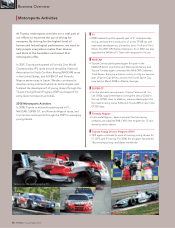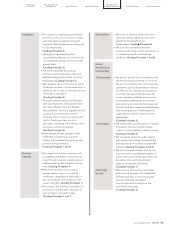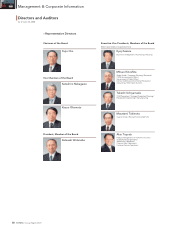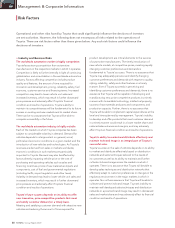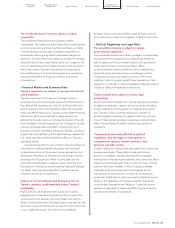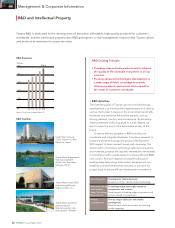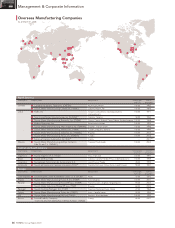Toyota 2008 Annual Report Download - page 62
Download and view the complete annual report
Please find page 62 of the 2008 Toyota annual report below. You can navigate through the pages in the report by either clicking on the pages listed below, or by using the keyword search tool below to find specific information within the annual report.
60 TOYOTA •Annual Report 2008 •
Operational and other risks faced by Toyota that could significantly influence the decisions of investors
are set out below. However, the following does not encompass all risks related to the operations of
Toyota. There are risk factors other than those given below. Any such risk factors could influence the
decisions of investors.
»Industry and Business Risks
The worldwide automotive market is highly competitive.
Toyota faces strong competition from automotive
manufacturers in the respective markets in which it operates.
Competition is likely to further intensify in light of continuing
globalization and consolidation in the worldwide automotive
industry. Factors affecting competition include product
quality and features, the amount of time required for
innovation and development, pricing, reliability, safety, fuel
economy, customer service and financing terms. Increased
competition may lead to lower vehicle unit sales and
increased inventory, which may result in further downward
price pressure and adversely affect Toyota’s financial
condition and results of operations. Toyota’s ability to
maintain its competitiveness will be fundamental to its future
success in existing and new markets and its market share.
There can be no assurances that Toyota will be able to
compete successfully in the future.
The worldwide automotive industry is highly volatile.
Each of the markets in which Toyota competes has been
subject to considerable volatility in demand. Demand for
vehicles depends to a large extent on general, social,
political and economic conditions in a given market and the
introduction of new vehicles and technologies. As Toyota’s
revenues are derived from sales in markets worldwide,
economic conditions in such markets are particularly
important to Toyota. Demand may also be affected by
factors directly impacting vehicle price or the cost of
purchasing and operating vehicles such as sales and
financing incentives, prices of raw materials and parts and
components, cost of fuel and governmental regulations
(including tariffs, import regulation and other taxes).
Volatility in demand may lead to lower vehicle unit sales and
increased inventory, which may result in further downward
price pressure and adversely affect Toyota’s financial
condition and results of operations.
Toyota’s future success depends on its ability to offer
new innovative, price competitive products that meet
and satisfy customer demand on a timely basis.
Meeting and satisfying customer demand with attractive new
vehicles and reducing the amount of time required for
product development are critical elements to the success
of automotive manufacturers. The timely introduction of
new vehicle models, at competitive prices, meeting rapidly
changing customer preferences and demands is
fundamental to Toyota’s success. There is no assurance that
Toyota may adequately perceive and identify changing
customer preferences and demands with respect to quality,
styling, reliability, safety and other features in a timely
manner. Even if Toyota succeeds in perceiving and
identifying customer preferences and demands, there is no
assurance that Toyota will be capable of developing and
manufacturing new, price competitive products in a timely
manner with its available technology, intellectual property,
sources of raw materials and parts and components, and
production capacity. Further, there is no assurance that
Toyota will be able to implement capital expenditures at the
level and times planned by management. Toyota’s inability
to develop and offer products that meet customer demand
in a timely manner could result in a lower market share and
reduced sales volumes and margins, and may adversely
affect Toyota’s financial condition and results of operations.
Toyota’s ability to market and distribute effectively and
maintain its brand image is an integral part of Toyota’s
successful sales.
Toyota’s success in the sale of vehicles depends on its ability
to market and distribute effectively based on distribution
networks and sales techniques tailored to the needs of
its customers as well as its ability to maintain and further
cultivate its brand image across the markets in which it
operates. There is no assurance that Toyota will be able to
develop sales techniques and distribution networks that
effectively adapt to customer preferences or changes in the
regulatory environment in the major markets in which it
operates. Nor is there assurance that Toyota will be able to
cultivate and protect its brand image. Toyota’s inability to
maintain well developed sales techniques and distribution
networks or a positive brand image may result in decreased
sales and market share and may adversely affect its financial
condition and results of operations.
Risk Factors
Management & Corporate Information


